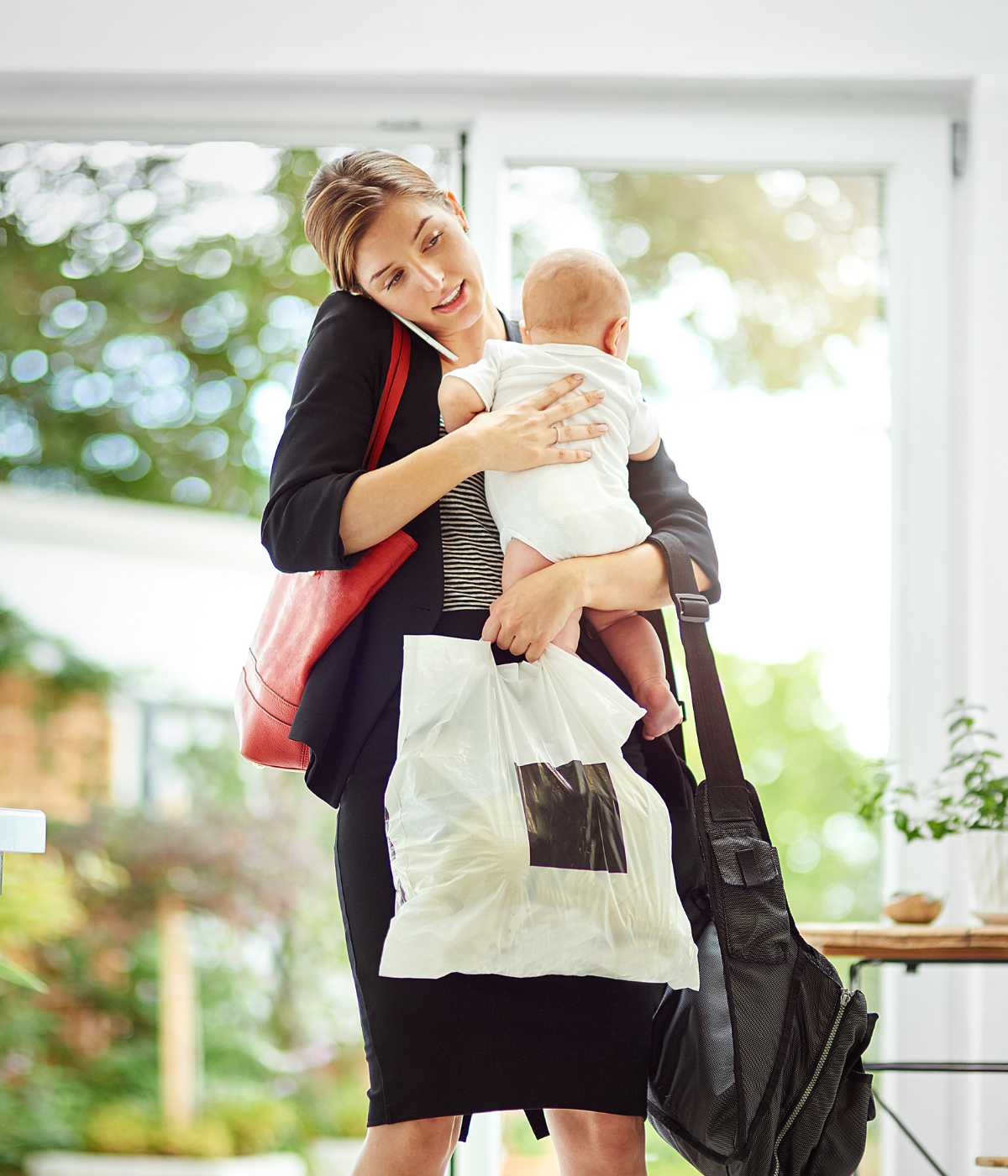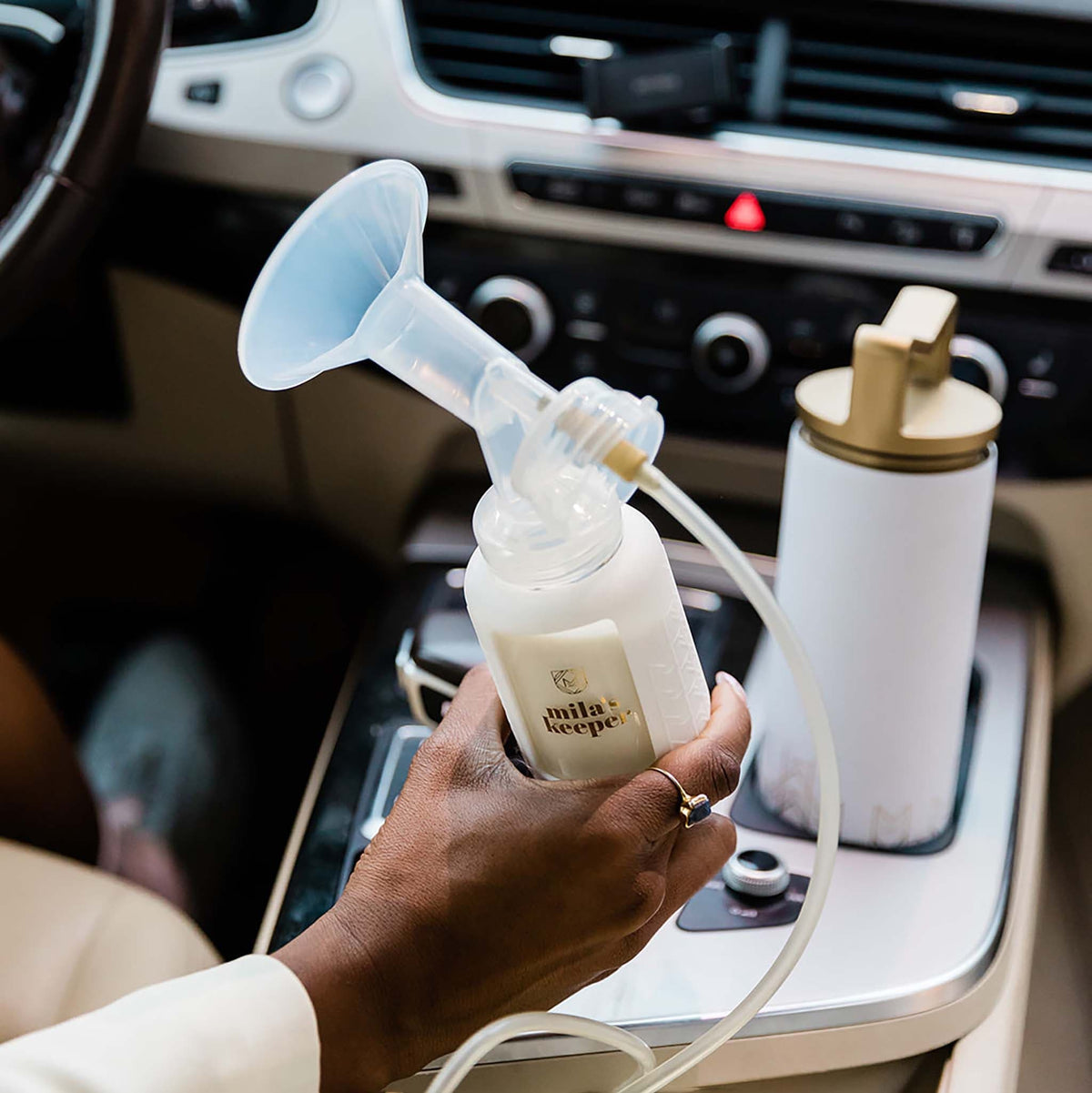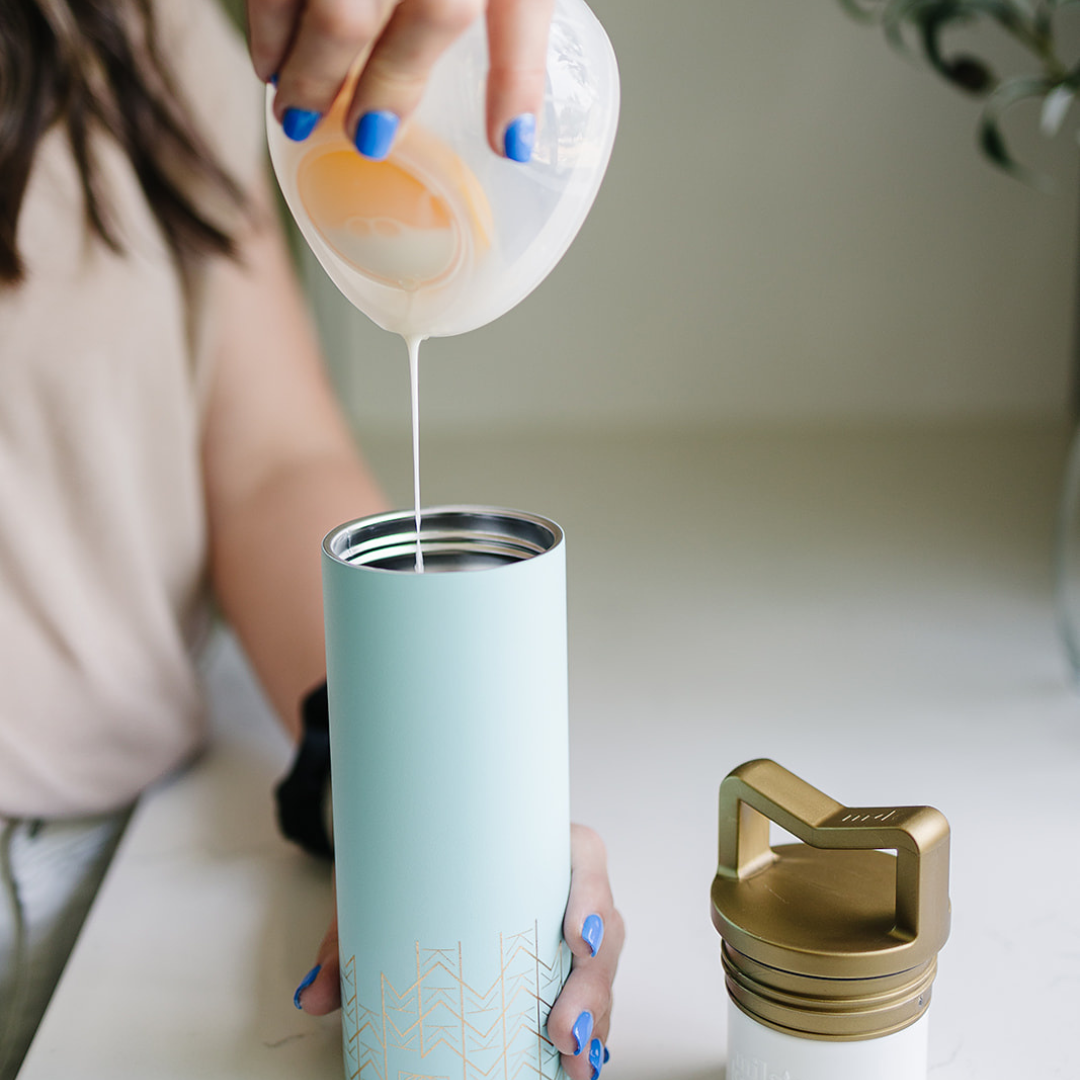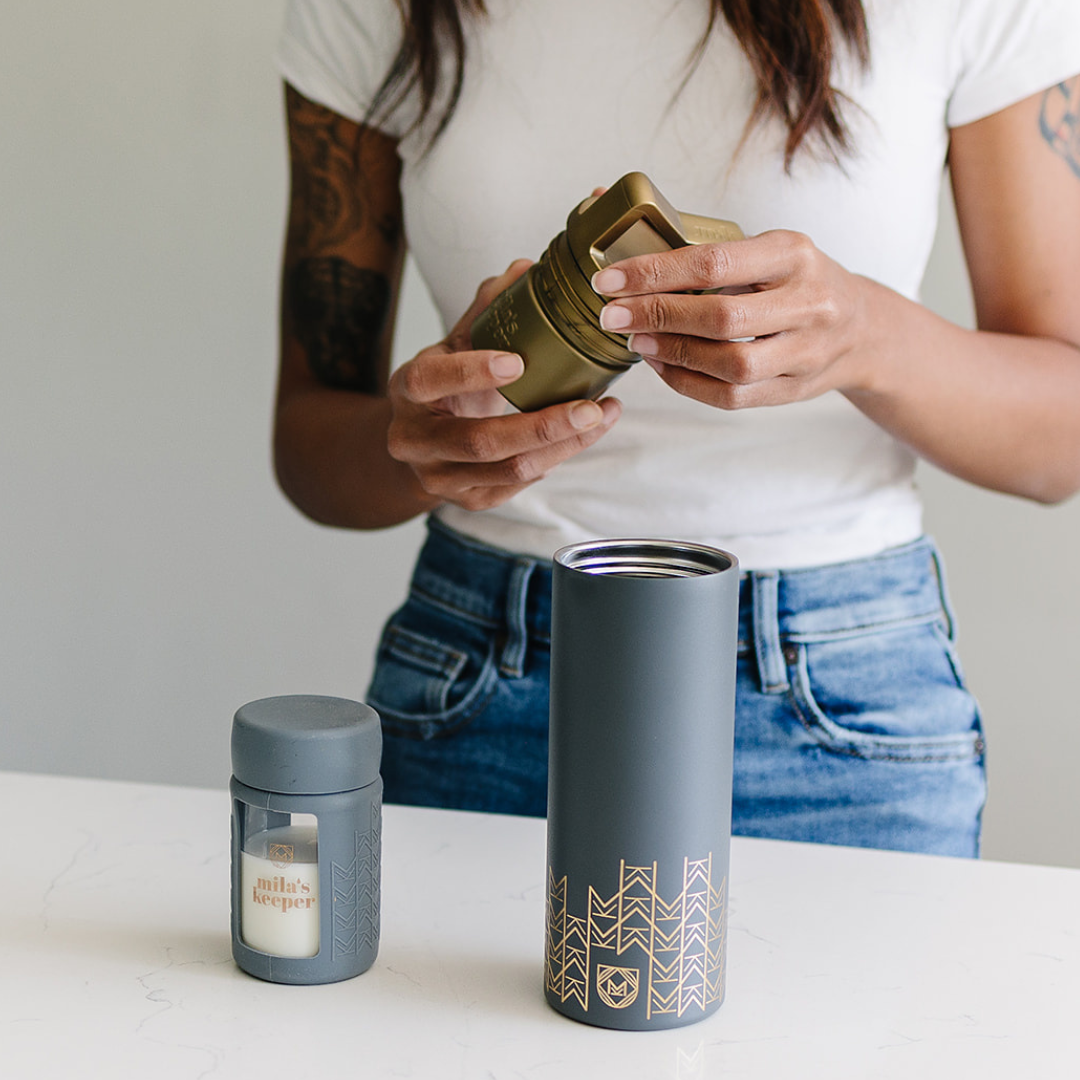Here at Mila’s Keeper, we’re always thinking of ways to make life easier for you busy mamas. It’s the holiday season, and for many of us, that means traveling. Whether you’re looking forward to these travels, or you’re already daydreaming of your return home, there’s always a lot to do and figure out before traveling.
If you’re breastfeeding and traveling with (or without) your child you have some additional things to figure out. All of this logistical stuff can add a bit more stress to your travel. We have some good information about traveling with breast milk, but we thought we’d focus today specifically on how to fly with breast milk. We hope this will give you some useful guidance and will give you the confidence to carry you off to your winter wonderland (or to escape from it) worry-free!
Use this article as a reference, but you should also check with the specific airlines, airports, and countries that you are traveling to and from to ensure that you have the most updated and accurate information available.

What are the laws?
If it seems like there is a different protocol every time you fly, or even at every airport you fly out of, you’re not alone. Sometimes you’re asked to take your shoes off, other times you get reprimanded for assuming your shoes need to come off. Sometimes you need to take your liquids out, other times they want you to keep it in the bag, and the same with electronics. It’s hard to keep it all straight!
This variation in protocols is likely due to the staggered installation of Computed Tomography (CT) X-ray systems into airports around the U.S. While some accounts of these different protocols make for funny TikToks, they can also make it frustrating to know what to do.
Knowing what to do with your shoes, electronics and liquids will be clearly stated on signage in the screening area, knowing what to do with your breast milk might require a little more research and is something you’ll want to know the specifics of before you even get to the airport.
Ever since the implementation of TSA’s 3-1-1 liquids rule, “breast milk, infant formula, baby/toddler food, toddler drinks, ice, gel, and freezer packs used to cool breast milk, and infant formula” have been exempt due to being categorized as medically necessary items.
TSA rules also state that “ice packs, freezer packs, gel packs, and other accessories may be presented at the screening checkpoint in a frozen or partially-frozen state to keep medically necessary items cool.”
So ideally, as long as you bring it to the attention of the TSA that you are traveling with these items, they should be permissible, possibly with additional screening. That is, of course, if the TSA agent you encounter is familiar with these guidelines!

Some background on recent changes/improvements
In 2016, President Obama signed the Bottles and Breastfeeding Equipment Screening Act (BABES Act) into law after there were so many accounts of unsettling behavior by TSA agents and their handling of breastmilk and pumping equipment. There were numerous accounts of travelers being forced to throw away expressed milk (liquid gold!) that, according to TSA regulations, they should have been able to carry on.
The Friendly Airports for Mothers Act (FAM) was signed into law in 2018. This law requires that all medium and large hub airports provide lactation areas beyond the screening area. Here is what FAM specifically outlines:
- A lactation area is a room or other location that “provides a location for members of the public to express breast milk that is shielded from view and free from intrusion from the public
- Has a door that can be locked
- Includes a place to sit, a table or other flat surface, and an electrical outlet
- Meets accessibility requirements for differently abled persons, including individuals who use wheelchairs
- Not located in a restroom
Of course, nothing is perfect, and as much as we all would hope that education around breastfeeding and pumping has improved, there are still gaps in that knowledge and issues persist. A new bill was introduced after a viral tweet that would address some of these shortcomings. This legislation would require the TSA:
- issue guidance promoting the hygienic handling of any breast milk, baby formula, or other infant nutrition products, as well as accessories required to preserve these products;
- consult with nationally recognized maternal health organizations in establishing and communicating this guidance; and
- update its guidance every five years to respond to emerging needs of parents and to account for developments in technology.
While it’s good to be familiar with all of the laws, guidelines, and regulations pertaining to flying with breast milk and pumping equipment, the CDC suggests you take it further and should have a copy of the TSA regulations for expressed milk to help you get through the screening process at the airport.

So what exactly can you fly with domestically?
With mounting baggage fees and the general hassle of checked baggage, it is no wonder that everyone attempts to carry on everything. Moreover, the potential for lost or re-routed luggage is always at the back of everyone’s mind whenever checking bags. We mentally (and literally) weigh every item we put into checked luggage. What can we live without for a day or two, or even forever? What about breast milk? Sure, it can be replenished, but tell that to a tired, hungry baby in the middle of the Seattle airport at 1:59 am (ugh)!
Well, good news if you’re traveling within the U.S.! You can keep your expressed milk in your carry-on luggage, along with frozen breast milk and cooling accessories. You don’t even need to have your child with you! Our glass breast milk containers and portable travel cooler for breastmilk are the perfect accompaniment for your travels and since our “colder than cold” ice packs will keep your breast milk cool for an impressive 20 hours, they’re seriously handy for the short or long haul!
If you’re traveling with your child, the CDC recommends that you nurse your child during takeoff and landing to ease ear pain during air pressure changes within the cabin. If you need to nurse or pump before your flight or during a layover, check to see if the airport has a lactation area so you can do it comfortably. If you think you’ll need to pump on the airplane, make sure you take your portable pump.
Trying to fit comfortably in an airplane seat is hard enough when you are by yourself. So sometimes you might be able to find an alternative seat where the row might be empty. Let the flight attendant know when you board the airplane and they will help you locate seating with additional room if available.
If you’re mid-flight and you need to warm up a bottle, most in-flight crews will assist you in warming up a bottle by giving you a cup of hot water to submerge the bottle in for a couple of minutes. Our MilKeeper has excellent thermal qualities and can be used as a milk warmer too! Remember to always test the temperature of the milk before giving it to your child. Also keep in mind that if you thaw out frozen breast milk, it’s good for about one to two hours and you will need to toss out the unfinished milk.

…And Internationally?
Perhaps you’re off to London or Prague or even Fiji for the holidays. Obviously, flying internationally is a whole different matter. First off, you will likely have a long, sometimes overnight flight ahead of you. In such cases, many airlines provide bassinets for infant passengers under a specific weight set by the airline. It makes all the difference on those long flights to be able to put your baby down somewhere comfortable for a nap (maybe you’ll be able to get a little shut-eye too). The bassinets are located in the bulkhead seats and are great for that extra leg room as well. You can make such arrangements with your airline while booking the flight. Some airlines will charge extra fees and others are given simply based on request.
When it comes to traveling with breast milk, most international destinations will allow you to have breast milk in your carry-on, although some stipulate that your child must be with you. Can you fly with frozen breast milk? Some countries allow you to bring frozen breast milk with you, while others don’t permit it. Generally, however, I have personally traveled in over a dozen countries with breast milk and have never had an issue. I have found that the screening agents are understanding, but one can never assume.
According to the UK government, for instance, “When traveling with a baby you’re allowed to take enough baby food, baby milk and sterilized water for the journey. There is no legal limit to how much you can take however check with your airport before you travel. You can carry breast milk in hand luggage even if you’re not travelling with a baby. You cannot carry frozen breast milk in hand luggage. Individual containers of breast milk must hold no more than 2,000ml. Each container will need to be screened at the security point. Airport staff might need to open the containers to screen the liquids.”
For the countries that don’t allow you to bring frozen milk as a carry-on, they may allow it in checked luggage, some allowing the use of dry ice, others not.
The rules vary depending on country and circumstance, so be sure to look into the regulations of the country you plan to fly into and out of and what their specific policies are. Limitations will vary depending on if you have your child with you or not, and how and where your breast milk is stored.
In a nutshell…
- Pack breast milk in leak-proof containers such as our portable breast milk coolers.
- Keep the breast milk in your carry-on luggage if allowable. You want to keep it on you especially if you’re traveling with your child and will need it on the flight!
- Use ice packs or frozen gel packs to keep breast milk cold. Make sure the ice packs are frozen solid before you pack them in your luggage.
- Consider bringing a small cooler or insulated bag to store the breast milk in while you are traveling. The MilKeeper is an excellent portable way to keep breast milk cold for up to 20 hours!
- Declare the breast milk at security. You may be asked to open the containers to inspect the contents, so it’s a good idea to pack the breast milk in a separate bag or container that’s easy to access. The TSA also recommends using a clear vessel to carry breast milk in such as a glass or see through plastic bottle.
- If you are traveling internationally, check the regulations for bringing breast milk into the country you are visiting. Some countries have restrictions on the amount of breast milk you can bring in, and whether or not your child needs to be present.
- If you need to pump during the flight, bring a portable breast pump. You can check with the flight attendant for a private area to pump in (maybe there’s an empty row?) or bring a nursing cover to use while pumping at your seat.
- If you are traveling with a baby, bring extra bottles or cups for feeding in case of delays or missed connections.
Wherever you’re flying to, we hope that this helps you get there with a little more ease. Everything we do here at Mila’s Keeper we do to make things a little easier for all the busy mamas out there! Let us know if you would like add anything - we'd love to hear from you!
Keep reading related blogs Your Guide to Successfully Traveling with Breast Milk
A female-designed and female-run company, Mila's Keeper is on a mission to empower women to thrive during their breastfeeding journey by offering reusable, eco-friendly breast milk storage solutions for their day-to-day needs. Get the latest tips and info on Mila's Keeper products by following us on Facebook, Twitter, Instagram, Pinterest, and LinkedIn.























